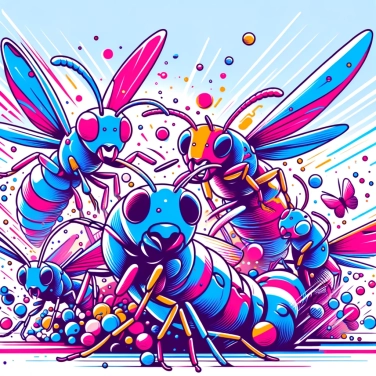In detail, for those interested!
Insect exoskeleton structure
The exoskeleton of insects is composed of chitin, a rigid and resistant substance. This external structure protects the internal organs of insects against predators and environmental conditions. The exoskeleton is formed of articulated segments that allow insects to move with agility. Its hardness varies depending on the species and stages of development of the insects. The exoskeleton of insects cannot grow, which is why insects molt in order to develop. During molting, the old exoskeleton is shed and a new soft exoskeleton is formed, which then hardens.
Regeneration capacity
The regenerative capacity of insects is remarkable. In case of injury, they have the ability to heal quickly. This ability is due to the presence of stem cells in their bodies, which can differentiate into various types of cells to replace those damaged. Insects can regenerate not only their external tissues, but also their internal organs, such as muscles and intestines, thanks to this process of cell regeneration. This ability allows them to survive difficult situations and be extremely resistant to injuries.
Physiological adaptations
Insects have a variety of physiological adaptations that contribute to their remarkable resilience. One of the most notable physiological characteristics is their ability to effectively regulate their body temperature. Insects can adjust their metabolism to produce heat or to dissipate it, allowing them to adapt to a wide range of environments.
In addition, insects have developed sophisticated mechanisms to manage their hydration. Their impermeable cuticle allows them to limit water loss, while specialized structures like spiracles and tracheae allow them to breathe efficiently while conserving water.
Insects have also evolved strategies to optimize their nutrient utilization. Their digestive system is adapted to efficiently extract nutrients from food, allowing them to thrive even in challenging food conditions.
Furthermore, insects have developed a variety of defense mechanisms against environmental stresses such as toxins, pathogens, and predators. Their immune system, though simpler compared to vertebrates, is effective in fighting infections and maintaining their health.
Finally, insects have evolved diverse and efficient reproductive mechanisms. Their ability to reproduce quickly and in large numbers allows them to survive and thrive despite environmental pressures.
These complex and varied physiological adaptations contribute to the remarkable resilience of insects in facing the challenges of their ever-changing environment.
Role of symbiotes
Symbiotes are organisms that live in close association with insects and play a crucial role in their survival and resistance. These symbiotic partners can be bacteria, fungi, or other living organisms.
Symbiotes provide insects with various benefits, such as the ability to digest difficult-to-breakdown substances, the synthesis of essential vitamins, or protection against pathogens. For example, some symbiotic bacteria present in the digestive system of insects can degrade complex plant compounds, allowing insects to feed on a variety of food sources.
Some symbiotes also produce chemical compounds that protect insects against predators or parasites. These symbiotic alliances can significantly contribute to insects' ability to survive in hostile environments.
In return, insects provide symbiotes with a stable environment and essential resources for their own survival. This mutually beneficial relationship between insects and their symbiotes is an essential aspect of the longevity and resistance of these small organisms to various environmental stresses.
![Explain why some countries change time zones?]()
![Explain why Alexander the Great refused to wear shoes.]()
![Explain why Alexander the Great always wore an impressive helmet.]()
![Explain why the last Chinese emperor was so young when he came to power?]()





















